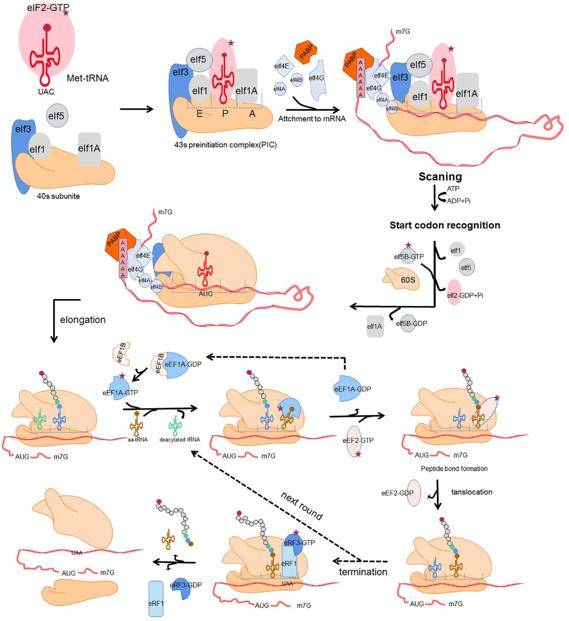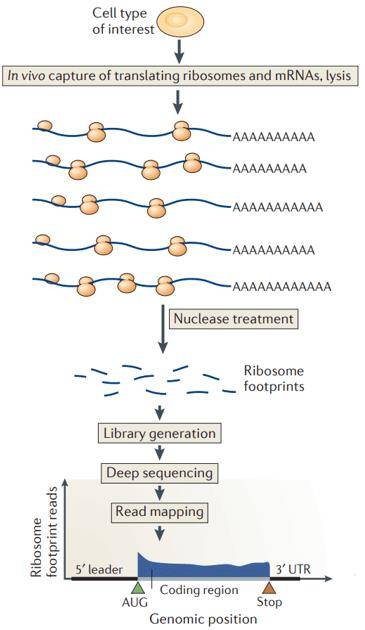Introduction
When delving into the intricate interplay of genes and proteins in the context of diseases, stress, or any biological phenomenon, researchers commonly turn to the transcriptome to examine changes in gene expression. The objective is to identify crucial genes that might influence phenotypic variations, often complemented with proteomics to uncover potential mechanisms of gene expression regulation. However, one question frequently arises: why do the changes in the expression of certain genes, as identified through differential analysis, not always align with corresponding protein levels? Are these genes truly non-contributors?
 Four fundamental phases of translation: initiation, elongation, termination and ribosome recycle. (Zhang et al., 2020)
Four fundamental phases of translation: initiation, elongation, termination and ribosome recycle. (Zhang et al., 2020)
In this article, we'll delve into the importance of understanding translational regulation, an often overlooked aspect of gene expression control. We'll explore how combining transcriptomics, proteomics, and translatomics can provide a more comprehensive understanding of gene regulation, shedding light on this critical yet frequently underestimated component of biological research.
Translational Regulation: The Missing Link
Within the central dogma of molecular biology, comprising RNA synthesis, RNA degradation, protein synthesis, and protein degradation, translational regulation stands out as the predominant factor. In fact, it exerts a greater influence on gene expression than the sum of all other regulatory mechanisms. This highlights its paramount significance in governing the intricate web of molecular processes within organisms.
The discrepancies noted earlier, where changes in gene expression do not correlate with corresponding protein expression, often stem from an oversight regarding translational regulation. To address these uncertainties and to foster innovation in gene regulation research, it's imperative to bridge the gap between the transcriptome, proteome, and translatome. This holistic approach facilitates a comprehensive study of global translation regulation, and it represents a pioneering concept in gene regulation research.
Unveiling the Translatome with Ribo-seq
One of the most commonly employed techniques for translatome sequencing is Ribo-seq (Ribosome profiling sequencing). This method involves the use of RNA enzymes to digest cellular RNA, yielding ribosome-protected RNA fragments known as ribosome footprints (RFs) actively involved in translation. These RFs, approximately 30 nucleotides in length, are subsequently isolated, deeply sequenced, and meticulously analyzed.
Please read the article Ribosome Profiling: Definition, Applications, Principles, and Workflow for more information.
Our Ribo-seq service empowers researchers to explore the genome-wide translation efficiency and to discover novel proteins and short peptides. By integrating translatome data with transcriptome and proteome data, one can calculate the translation efficiency of RNA, assess the impact of transient translation on protein accumulation, and unearth insights into post-transcriptional and translation regulation mechanisms. Translatome sequencing functions as the crucial bridge connecting RNAs and proteins, enabling in-depth analysis of gene translation at various levels, regions, and rates.
 Workflow for ribosome profiling (Brar and Weissman 2015).
Workflow for ribosome profiling (Brar and Weissman 2015).
Beyond the Translatome: A Multifaceted Approach
Translatome sequencing initially gained prominence through studies in yeast, expanding subsequently to encompass numerous species. Notably, research in animals, with a focus on humans and mice, has dominated this field, while investigations in plants remain relatively scarce. This disparity in attention highlights the untapped potential and opportunities for exploring translational regulation in a broader spectrum of organisms.
Conclusion
Understanding the full spectrum of gene regulation necessitates comprehensive exploration beyond the transcriptome and proteome. Translatomics, especially through Ribo-seq, offers a promising avenue for unlocking the mysteries of translation regulation. By merging data from the transcriptome, proteome, and translatome, researchers can uncover the intricate post-transcriptional and translational regulatory mechanisms governing the dynamic world of gene expression. As the study of translatomics expands, it holds great promise for advancing our understanding of the intricate interplay between genes and proteins in diverse organisms, ultimately contributing to groundbreaking discoveries in the life sciences.
References:
- Zhang, Shuxia, et al. "Insights into translatomics in the nervous system." Frontiers in Genetics 11 (2020): 599548.
- Brar G A, Weissman J S. Ribosome profiling reveals the what, when, where and how of protein synthesis. Nature reviews Molecular cell biology, 2015, 16(11): 651-664.
For research purposes only, not intended for clinical diagnosis, treatment, or individual health assessments.


 Sample Submission Guidelines
Sample Submission Guidelines
 Four fundamental phases of translation: initiation, elongation, termination and ribosome recycle. (Zhang et al., 2020)
Four fundamental phases of translation: initiation, elongation, termination and ribosome recycle. (Zhang et al., 2020) Workflow for ribosome profiling (Brar and Weissman 2015).
Workflow for ribosome profiling (Brar and Weissman 2015).